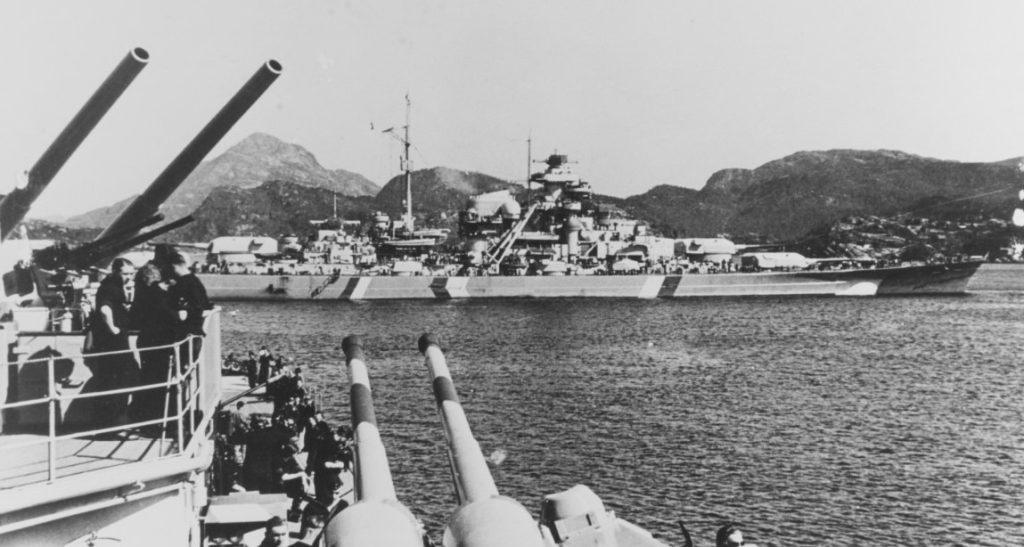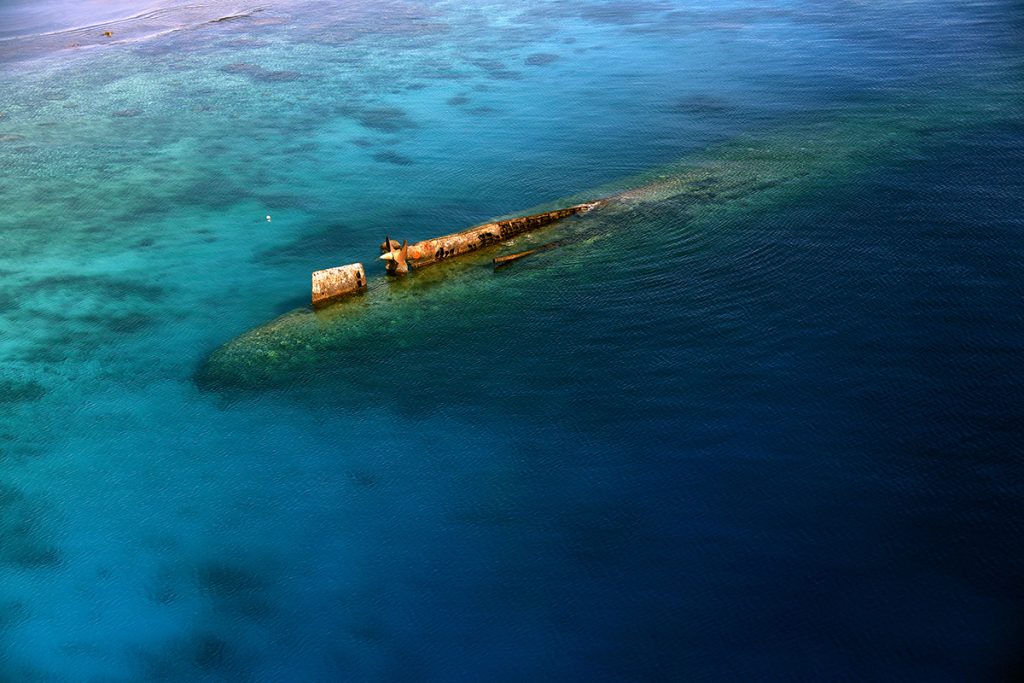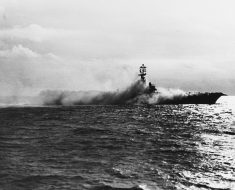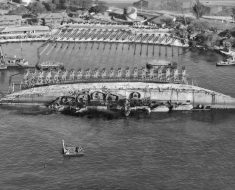The Prinz Eugen, a prominent heavy cruiser of the German Kriegsmarine, served extensively during World War II, becoming known for its participation in the Battle of the Denmark Strait alongside the battleship Bismarck.
In October 1944, during movements in the Baltic Sea, Prinz Eugen collided with the light cruiser Leipzig, an incident that nearly severed the Leipzig in half.
After the war, Prinz Eugen was transferred to the United States Navy, where it was used as a target ship in the 1946 Operation Crossroads nuclear tests at Bikini Atoll.
The cruiser ultimately capsized and sank at Kwajalein Atoll in December 1946, after being heavily contaminated with radiation from the nuclear tests.
Contents
- Design of the Prinz Eugen
- Early Operational History
- The Channel Dash and Operations in the Baltic
- The Prinz Eugen’s Collision With the Leipzig
- The Prinz Eugen After the War
- Sinking of the Prinz Eugen
Design of the Prinz Eugen
The Prinz Eugen was designed under the limitations and guidelines set by the Anglo-German Naval Agreement of 1935, which allowed Germany to build a navy up to 35% of the size of the British Royal Navy. The cruiser was part of the Admiral Hipper-class, intended to outgun any cruiser fast enough to catch it, and outrun anything powerful enough to sink it.
Read More U-995 – The German Submarine you can Visit
The hull of the Prinz Eugen was constructed with longitudinal steel frames, designed to increase structural integrity while allowing for more weight in armament and armor. The cruiser’s armor was robust, featuring a main belt that was 70 to 80 mm thick, a deck that was up to 50 mm thick, and turrets with up to 105 mm of steel plating. This was designed to protect against shellfire from other cruisers and smaller capital ships.

The ship’s primary armament consisted of eight 20.3 cm SK C/34 guns in four twin turrets, two forward and two aft, which could fire at a range of up to 36,000 meters. Secondary armament included twelve 10.5 cm L/65 SK C/33 anti-aircraft guns, twelve 3.7 cm SK C/30 anti-aircraft guns, and eight 2 cm anti-aircraft guns.
This diverse range of weaponry enabled the Prinz Eugen to engage a variety of air and sea targets effectively. Additionally, the cruiser was equipped with twelve 53.3 cm torpedo tubes spread across four triple launchers, providing significant offensive capabilities against both naval and merchant targets.

Propulsion was provided by three sets of geared steam turbines, each driving one propeller shaft, using steam generated by twelve high-pressure, ultra-high temperature boilers. This powerplant enabled the Prinz Eugen to reach speeds of up to 32 knots, making it one of the fastest heavy cruisers of its time. The design also included a double bottom that spanned approximately 85% of the hull’s length, enhancing the ship’s survivability in the event of underwater damage.
Read More That Time the USS Wisconsin Collided With a Destroyer
The cruiser’s electronic suite was advanced for its time, featuring radar systems such as the FuMO 23, which was crucial for detecting enemy ships and aircraft at long range. This technology gave the Prinz Eugen a significant advantage in night engagements and in poor visibility conditions.
Early Operational History
The Prinz Eugen’s early service in the Atlantic Ocean was characterized by its role in Germany’s strategy of disrupting Allied shipping lanes. Departing from Germany in April 1941, Prinz Eugen, along with its sister ship Admiral Hipper, undertook Operation Rheinübung, a mission to attack Allied merchant shipping and convoys. This operation aimed to weaken the British war effort by targeting its supply lines across the Atlantic.
During this period, the Prinz Eugen demonstrated its capabilities as a commerce raider, engaging and sinking several Allied merchant vessels. These actions not only disrupted Allied supply routes but also instilled fear among merchant mariners, who now had to contend with the threat posed by German surface raiders.
Read More S-130 – The Last Remaining German E-Boat
The most notable engagement in Prinz Eugen’s early service occurred during the Battle of the Denmark Strait on May 24, 1941. Alongside the battleship Bismarck, Prinz Eugen was tasked with intercepting and destroying Allied convoys between North America and Britain.

During the battle, Prinz Eugen and Bismarck encountered the British battlecruiser HMS Hood and the battleship HMS Prince of Wales. The engagement proved catastrophic for the Royal Navy, as a shell from Bismarck struck the magazine of HMS Hood, causing a massive explosion that sank the ship within minutes. This event marked the destruction of one of the Royal Navy’s most iconic vessels and demonstrated the firepower of the German surface fleet.
Read More The Longest-Range Naval Hit – The Record Belongs to Two Ships
While Prinz Eugen participated actively in the engagement, providing supporting fire and engaging enemy vessels, it emerged from the battle relatively unscathed compared to Bismarck. After inflicting significant damage on HMS Prince of Wales, Prinz Eugen broke off from Bismarck due to fuel shortages and headed towards occupied France.
The Channel Dash and Operations in the Baltic
The Channel Dash, also known as Operation Cerberus, was a daring and meticulously planned naval operation conducted by the German Navy (Kriegsmarine) in February 1942. The operation aimed to move the battleships Scharnhorst and Gneisenau, accompanied by the heavy cruiser Prinz Eugen, from the French port of Brest to German ports in the North Sea, via the English Channel. This movement was essential to consolidate German naval forces in the face of increasing Allied air and naval superiority in the Atlantic.

The Channel Dash was a remarkable demonstration of the Kriegsmarine’s ability to evade detection and interception by the Royal Navy and the Royal Air Force. Despite being detected by British reconnaissance aircraft and shadowed by British naval forces, the German task force successfully navigated the narrow and heavily defended waters of the English Channel under the cover of darkness and bad weather. The element of surprise, combined with the speed and firepower of the German ships, allowed them to evade the Allied blockade and reach their destination safely.
The success of the Channel Dash dealt a significant blow to British naval prestige and raised questions about the effectiveness of Allied naval defenses. It also demonstrated the vulnerability of Allied shipping routes in the Atlantic and forced a reassessment of naval strategy and tactics by Allied commanders.
Operations in the Baltic
Following the Channel Dash, Prinz Eugen was deployed to the Baltic Sea, where it participated in various operations against Soviet forces on the Eastern Front. The Baltic theater of operations presented a different set of challenges and objectives for Prinz Eugen compared to its previous engagements in the Atlantic.

In the Baltic, Prinz Eugen’s primary role was to provide fire support to German troops engaged in land battles along the Baltic coastline. The cruiser’s powerful guns and artillery were used to bombard Soviet positions, coastal fortifications, and enemy supply lines, thereby supporting German ground offensives and defensive operations.
Read More Fort Funston had 16-inch Battleship Guns
Additionally, Prinz Eugen conducted reconnaissance missions, escort duties, and anti-submarine patrols in the Baltic Sea, contributing to the overall security and protection of German naval and coastal installations in the region. Despite the challenging conditions and increasing Allied air and naval presence, Prinz Eugen continued to operate effectively in the Baltic theater until the final months of the war.
The Prinz Eugen’s Collision With the Leipzig
The collision between the heavy cruiser Prinz Eugen and the light cruiser Leipzig occurred on October 15, 1944.
The Prinz Eugen was on a return voyage to the German controlled port in Gotenhafen, Poland, when, due to the thick fog, she rammed the German light Cruiser Leipzig amidship.
During the collision, the Leipzig was in the process of transitioning from her diesel cruise engines to her steam turbine main engines. This involved uncoupling the diesels from the shafts and then coupling the turbines, temporarily leaving the ship without propulsion. As a result, the Leipzig drifted out of her fairway and into the path of the Prinz Eugen, which was moving in the opposite direction.

The Prinz Eugen struck the Leipzig on her port side, just forward of her funnel, causing severe damage. The collision nearly split the Leipzig in half, with the forward point of the Prinz Eugen’s clipper bow protruding beyond the starboard side of the Leipzig. The impact destroyed the number 3 (port) engine room, flooded a second engine room, and resulted in the deaths or injuries of 39 crewmen. The ships remained stuck together for around fourteen hours before being separated.
Read More HMS Dreadnought was the Only Battleship to Ever Sink a Submarine
The Prinz Eugen made her way back to Gotenhafen for repairs, which were completed within a month. The Leipzig, however, was towed to Gotenhafen where it was deemed that the extent of the damage rendered repairs impractical, particularly given Germany’s critical military circumstances by late 1944. Consequently, only minimal repairs were undertaken to maintain the Leipzig afloat in the harbor.

After her repairs were completed, the Prinz Eugen continued operations in the Baltic.
The Prinz Eugen After the War
As World War II drew to a close in Europe with the unconditional surrender of Germany in May 1945, the fate of the German naval fleet, including the heavy cruiser Prinz Eugen, became a subject of significant Allied interest. The Prinz Eugen, being one of the most modern and technologically advanced ships in the Kriegsmarine, was particularly valuable.
Read More The USS Minneapolis Had a Bow Made From Coconut Trees
The ship was located in Copenhagen, Denmark, at the time of Germany’s surrender and was quickly taken over by British forces. This capture was part of the broader effort to secure high-value German assets that could potentially contribute to post-war military and technological advances.

Following its surrender, Prinz Eugen, along with numerous other German ships, was divided among the Allies as war reparations. The decisions regarding the allotment of these ships were influenced by the desire to study German technology, which was considered advanced in several respects. In the case of Prinz Eugen, the United States showed a specific interest due to the ship’s modern engineering and armaments, which offered valuable insights into German naval capabilities and design philosophy.
In January 1946, under the terms negotiated by the Allies, Prinz Eugen was formally transferred to the United States Navy. This transfer involved towing the ship from Copenhagen to Wilhelmshaven, Germany, where it joined other surrendered German vessels.
Read More The USS Texas ‘Sank’ Herself on D-Day
The ship was then prepared for a transatlantic voyage to Boston, United States, under the command of a mixed American and German crew. This crew was responsible for maintaining the ship during its passage, which was not only a logistical challenge given the ship’s condition and the need to prevent further deterioration but also a unique instance of cooperation between former wartime adversaries.
Operation Crossroads
Operation Crossroads was a pivotal series of nuclear tests conducted by the United States in the summer of 1946 at Bikini Atoll in the Marshall Islands. These tests were designed to evaluate the effects of atomic bombs on naval ships, equipment, and biological systems, and to demonstrate the power of the atomic arsenal the U.S. had developed during the Manhattan Project.

The operation was also a response to growing geopolitical tensions in the early Cold War era, serving as a display of military might to international audiences, including the Soviet Union.
Prinz Eugen was selected as one of the target ships for these tests due to its modern design and recent wartime activity. The ship was representative of advanced naval engineering, and studying its resilience to nuclear blasts provided valuable insights into the effectiveness of existing naval architectures against nuclear warfare. This selection marked a significant shift in the ship’s operational history, from a combat vessel to a subject in a groundbreaking military experiment.
Read More Japan’s Surrender was Signed on Board the USS Missouri
In July 1946, Prinz Eugen participated in two specific tests: Test Able and Test Baker. Test Able was an airburst detonation, where an atomic bomb was exploded approximately 520 feet above the target fleet. Prinz Eugen was positioned approximately one mile from the epicenter of the blast. Remarkably, the ship sustained only minor damage in this test, demonstrating significant resilience despite the proximity to the explosion.

Test Baker was conducted three weeks later and involved an underwater detonation. This test aimed to assess the effects of a nuclear explosion below the water’s surface, simulating a scenario where a bomb might detonate near or under a ship. Prinz Eugen again survived but suffered more serious damage, including significant radioactive contamination. The underwater shock wave and subsequent radioactive water column subjected the ship to harsher conditions than the airburst.
Following the tests, Prinz Eugen was heavily contaminated with radioactive fallout, making it unsafe for crew habitation and further active service. The ship was towed to Kwajalein Atoll, where it was subjected to extensive studies by U.S. scientists and engineers. These studies focused on decontamination processes, the structural integrity of the ship post-detonation, and the long-term effects of radioactive exposure on naval equipment.
Read More 3 Sailors Were Trapped in the West Virginia for 16 Days After the Pearl Harbor Attack
The data gathered from Prinz Eugen and other ships involved in Operation Crossroads played a crucial role in shaping U.S. military strategy regarding the use of nuclear weapons in naval warfare. It also influenced the design of future naval vessels, leading to enhancements in shielding, structural resilience, and understanding of radioactive decontamination procedures.
Sinking of the Prinz Eugen
After surviving the two nuclear detonations of Operation Crossroads at Bikini Atoll, the Prinz Eugen was left significantly contaminated with radioactive fallout. Despite surviving the physical impacts of the blasts relatively intact, the lingering radioactivity posed a serious hazard. Consequently, the decision was made to tow the ship to Kwajalein Atoll for further study and to minimize the risk of contaminating other areas.
Upon arrival at Kwajalein, the Prinz Eugen was extensively examined by scientists and engineers. These studies were aimed at understanding the effects of radiation on naval vessels, including structural integrity and material deterioration under radioactive conditions. However, as the ship was thoroughly contaminated, it was deemed unsafe for any potential reuse or extensive repair.

While moored at Kwajalein Atoll, Prinz Eugen began to list gradually. This was due to water ingress through hull breaches and damaged seals, effects likely exacerbated by the structural stresses from the nuclear tests. Despite efforts to stabilize and maintain buoyancy, the ship continued to take on water. In December 1946, the condition worsened, and Prinz Eugen ultimately capsized.
Read More A US Destroyer Fired a Torpedo at the USS Iowa While the President was on Board
The sinking was not a planned scuttling but rather an unintentional result of the damage sustained and the ongoing issues with maintaining the ship’s integrity post-tests. The cruiser came to rest on its port side in shallow water, leaving parts of its superstructure and hull visible above the waterline.
The final sinking of Prinz Eugen at Kwajalein Atoll turned the site into a unique historical and environmental artifact. The ship, resting just below the surface, became an accessible wreck for divers and a point of interest for both historical and scientific studies. Over the years, the site has provided valuable insights into the long-term environmental impacts of radioactive contamination in marine environments.







